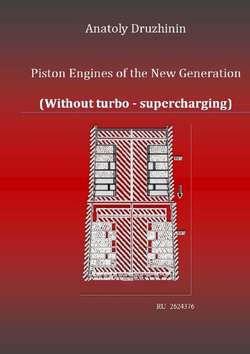Piston Engines of the New Generation (Without turbo – supercharging)

Реклама. ООО «ЛитРес», ИНН: 7719571260.
Оглавление
Anatoly Matveevich Druzhinin. Piston Engines of the New Generation (Without turbo – supercharging)
About the author
The author
Preface
Introduction
Sealing Piston Devices
§1. Influence of the gas dynamics on the operation of a piston sealing ring
§2. The gas dynamics at the different cycles of the engine operating cycle
– Working step “compression” of a fresh charge of air, fuel-air mix and its ignition
§3. The practical solutions from the theoretical conclusions
The oil-removable piston devices
§1. Physical and chemical features of engine oil
§2. The geometry of the oil-removable piston ring and the “pumping” effect
§3. The oil-removable piston devices
PISTON DEVICES OF ENGINES AND COMPRESSORS
This is well implemented on a simple atmospheric engine without any additional “boost” systems
THERMODYNAMICS IN CALCULATION OF CPG ELEMENTS OF THE ENGINE
EFFICIENT USE OF WATER IN INTERNAL COMBASTION ENGINES
The device works as follows
TWO-STROKE OR FOUR-STROKE ENGINES?
CYLINDER-PISTON GROUP AND ECOLOGY OF THE ENGINE
CONCLUSION
BIBLIOGRAPHICAL LINKS
Useful models
Отрывок из книги
The book gives an analysis of mistakes in the generally accepted calculations of piston rings, carried out without taking into account the influence of physical laws on the operation of rings (gas dynamics, hydraulics and thermodynamics). Based on the analysis, the formula of determining the piston ring height was initially obtained. Essentially new designs of “piston devices” have been developed, in which the sealing and oil-removal piston rings are located in one piston bore located at the top of the piston. Integral construction of the piston device increases the efficiency of the engine, its power and life, reduces fuel and engine oil consumption, improves the environmental characteristics of the engine and eliminates the need for turbocharging.
The book presents updated and revised information on previous editions, adapted to the features of powerful and heavy-duty engines and compressors. The temperature changes in the shape and dimensions of the cylinder, a new piston rings combined into one contraction reduce to a minimum mechanical friction losses, to increase the engine power and resource, to reduce fuel consumption, to increase oil replacement terms, to improve ecological indicators of the engines. The design excludes application of a turbo-supercharging. The modernization concerns the cylinder-piston group of the engines or compressors, and it does not require fundamental changes in technological processes. The conditions have been created for the use of water in engine processes, and the increased competitive advantages of two-stroke engines was justified.
.....
The engine losses may be objective, because of any physical process occurring within the construction, which is difficult for the developer and user to use during the operation of the product. But they can also be subjective because of the human factor that allows mistakes in the design, manufacture and operation of an energy device.
To significantly increase the efficiency of the engine, it was necessary to identify these errors and propose designs that exclude these losses, or reduce them to a negligible minimum. The example above shows that the opponent of the KAMAZ engine, the losses is much smaller and this naturally affects the efficiency of the engine, its shape and content.
.....